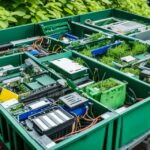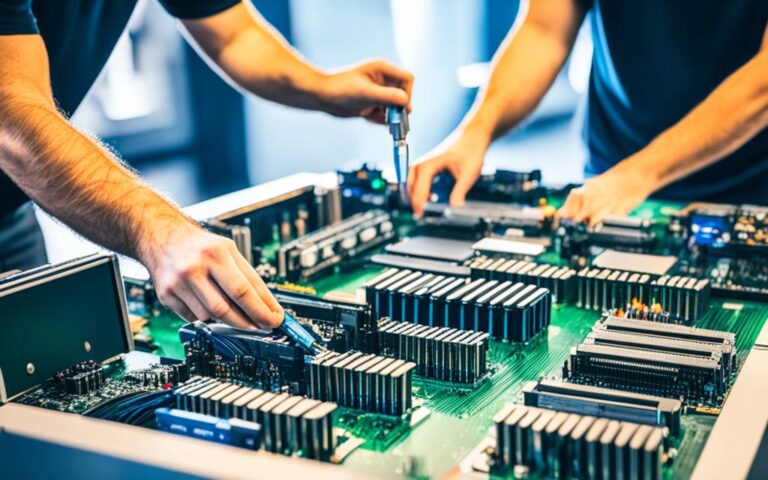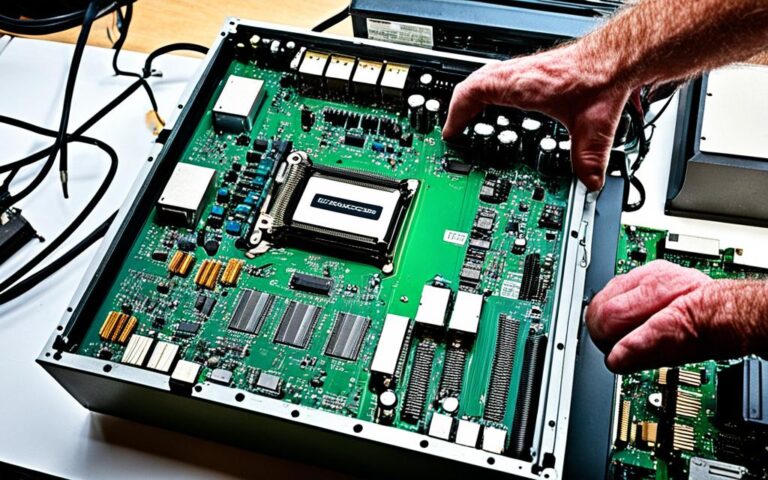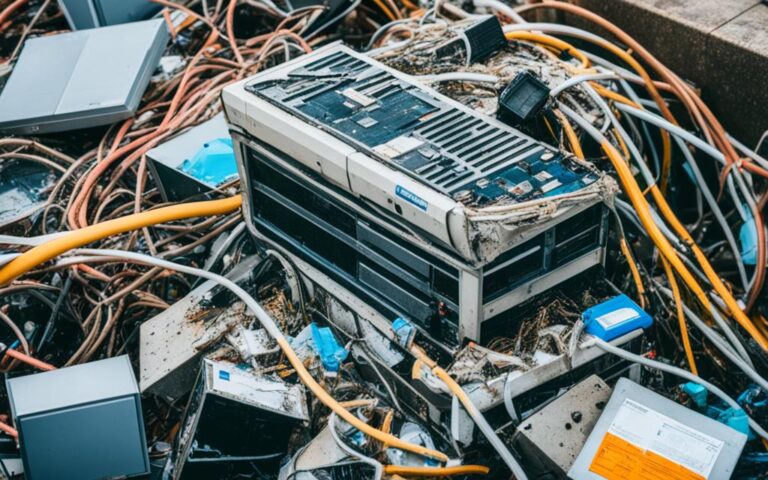Revolutionizing Waste: Zero-Waste Computer Processing
Zero-Waste Computer Processing is a cutting-edge innovation in sustainable technology that aims to revolutionize waste management in the computer industry. With the increasing amount of waste being generated by electronic devices, this innovative approach utilizes AI and robotics to achieve zero waste goals and create a more eco-conscious computing environment. By adopting zero-waste practices, companies can reduce their environmental footprint and contribute to a more sustainable future.
What is Smart Waste Management?
Smart waste management is a modern approach to waste collection and management that utilizes technology and data to create a more efficient and cost-effective system. This approach involves the use of IoT (Internet of Things) technology, where sensors are used to monitor waste levels and categorize the waste into specific categories. The data collected is then processed and turned into actionable insights, allowing companies to optimize waste management processes and improve recycling efforts.
By implementing smart waste management systems, companies can revolutionize the way waste is managed and contribute to a more sustainable future. These systems provide numerous benefits, including:
- Efficient Waste Collection: Smart waste management systems use sensors to monitor waste levels in real-time, allowing companies to optimize waste collection schedules and reduce unnecessary pickups.
- Waste Categorization: IoT sensors help categorize waste into specific categories, such as recyclables, organic waste, and general waste. This categorization enables efficient sorting and disposal, minimizing contamination and maximizing recycling efforts.
- Data-Driven Insights: The data collected by smart waste management systems provides valuable insights into waste generation patterns, allowing companies to make informed decisions regarding waste management processes and resource allocation.
- Cost Savings: By streamlining waste collection and optimizing recycling efforts, smart waste management systems can result in significant cost savings for companies, reducing operational expenses and improving efficiency.
The Role of IoT in Smart Waste Management
“IoT technology plays a crucial role in smart waste management, enabling real-time monitoring, data collection, and seamless communication between waste management systems and stakeholders.” – Waste Management Solutions Ltd.
IoT devices, such as waste level sensors and monitoring platforms, are deployed across waste collection points, enabling constant monitoring of fill levels and providing accurate data on waste volumes. These sensors transmit real-time information to a central management system, allowing waste management companies to efficiently plan waste collection routes and optimize resource allocation.
Moreover, IoT technology facilitates remote monitoring, reducing the need for manual waste checks and ensuring timely waste collection and disposal. Smart waste bins equipped with sensors can send notifications when they reach their capacity, preventing overflowing bins and maintaining cleanliness.
Smart Waste Management: Enhancing Waste Data Processing
Waste data processing is a crucial component of smart waste management systems. The data collected from IoT sensors is processed and analyzed to generate actionable insights that drive waste management decisions.
Advanced data analytics and machine learning algorithms help identify waste generation trends, seasonality patterns, and peak waste hours, enabling companies to allocate resources effectively and optimize waste collection routes. Additionally, waste data processing allows for better monitoring of recycling efforts, ensuring compliance with regulations and improving overall recycling rates.
Implementing smart waste management systems not only improves the efficiency of waste collection and disposal but also promotes sustainable waste management practices. By harnessing the power of technology and data, companies can minimize their environmental impact, reduce costs, and contribute to a greener future.
How Does Smart Waste Management Work?
Smart waste management systems rely on IoT technology to monitor and manage waste. Waste level sensors track the fill level of trash bins, enabling efficient waste collection and maintenance of hygiene. Utilizing AI technology, recycling robots are employed to identify and separate recyclable materials from non-recyclable waste, improving the accuracy and efficiency of the recycling process. To optimize waste collection routes and reduce environmental impact, garbage-truck load monitoring involves the use of weighing sensors to predict fill levels and minimize greenhouse gas emissions and traffic congestion.
By leveraging IoT technology, waste level sensors, AI recycling robots, and garbage-truck load monitoring, smart waste management systems enable more effective waste management and contribute to a sustainable future.
| Key Technologies | Function |
|---|---|
| IoT technology | Monitors waste and enables efficient waste collection |
| Waste level sensors | Tracks fill levels of trash bins for optimized waste management |
| AI recycling robots | Identifies and separates recyclable materials from non-recyclable waste |
| Garbage-truck load monitoring | Weighing sensors predict fill levels and optimize collection routes |
E-Waste Management
E-waste management is a critical aspect of waste management, considering the hazardous materials present in electronic devices. E-waste, which represents a small portion of total waste but has a significant environmental impact, requires special attention.
E-waste programs, such as e-waste kiosks, have been introduced to encourage the proper disposal and recycling of electronic devices. These kiosks utilize smart technology to assess the condition of devices and determine the most appropriate disposal method, ensuring that hazardous materials are safely handled and recycled.
Proper management of e-waste is crucial to prevent environmental pollution and the harmful effects of toxic substances. According to the United Nations, only 20% of e-waste is recycled globally, highlighting the need for effective e-waste management solutions.
“E-waste contains hazardous substances like lead, mercury, and cadmium, which can have detrimental effects on the environment and human health if not properly managed,” said Dr. Emily Green, an environmental scientist.
E-waste kiosks provide individuals and businesses with a convenient and responsible way to dispose of electronic devices, ensuring that valuable materials are recovered and recycled. These kiosks accept a wide range of electronic waste, including old computers, mobile phones, and other electronic gadgets.
By promoting e-waste recycling through accessible and user-friendly solutions like e-waste kiosks, we can contribute to a cleaner environment and the efficient use of resources. It is essential for individuals and organizations to make use of these facilities and play their part in sustainable waste management.
Innovations in Waste Processing
Innovations in waste processing play a crucial role in improving waste management at the disposal point. These advancements not only optimize waste management efforts but also support environmentally friendly practices. Two key innovations that are transforming waste processing are solar-powered trash compactors and smart waste bins, including the revolutionary TrashBot.
Solar-Powered Trash Compactors
Solar-powered trash compactors are designed to efficiently reduce the size of trash and extend the time between collections. By compacting the waste, these innovative compactors can hold a significantly larger amount of trash, reducing the frequency of collection trips. This not only saves time and resources but also minimizes fuel consumption and greenhouse gas emissions associated with waste collection. The use of solar power ensures a sustainable energy source, making these trash compactors eco-friendly and cost-effective.
Smart Waste Bins and TrashBot
Smart waste bins equipped with advanced technologies are revolutionizing waste processing. These bins, including the cutting-edge TrashBot, utilize artificial intelligence (AI), computer vision, and robotics to automatically sort waste at the point of disposal. TrashBot’s AI-powered system accurately identifies and categorizes different types of waste, facilitating efficient recycling. This technology reduces contamination and improves recycling accuracy, ultimately contributing to a more sustainable waste management process.
TrashBot is transforming waste processing by revolutionizing waste sorting and recycling accuracy. Its advanced AI and robotics capabilities make it a game-changer in the fight against contamination and inefficiency.
These innovations in waste processing not only optimize waste management but also inspire a shift towards a more sustainable and environmentally conscious approach. By reducing the size of trash and improving recycling accuracy, solar-powered trash compactors, smart waste bins like TrashBot, and other similar technologies are instrumental in creating a cleaner, greener future.
| Innovation | Benefits |
|---|---|
| Solar-powered trash compactors | – Reduces trash volume – Extends time between collections – Minimizes fuel consumption and greenhouse gas emissions |
| Smart waste bins and TrashBot | – Automatic waste sorting – Improved recycling accuracy – Reduces contamination – Promotes sustainable waste management |
AI in Waste Management: Benefits and Outlook
AI in waste management offers numerous benefits, including improved public health, cost savings, and the optimization of recycling efforts. By harnessing the power of artificial intelligence, waste sorting systems can enhance recycling processes, reducing contamination and increasing the recovery of valuable resources from waste.
One of the key advantages of AI in waste management is its ability to enable predictive models for waste generation. This allows for proactive planning and resource allocation in waste management systems, leading to more efficient operations and optimal resource utilization.
Furthermore, the integration of AI in waste-to-energy solutions plays a vital role in sustainable resource utilization. By leveraging AI technologies, waste-to-energy plants can optimize energy production, reduce reliance on fossil fuels, and minimize environmental impact.
The Role of AI in Improving Public Health
AI’s contribution to waste management extends beyond environmental benefits. It also plays a critical role in improving public health. AI-powered waste sorting systems eliminate the need for manual sorting, reducing the risk of exposure to potentially hazardous materials for waste management workers.
In addition, AI enables the identification and separation of medical waste, ensuring proper disposal and preventing the spread of infections. With AI’s ability to detect and categorize different types of waste accurately, it significantly improves the safety and effectiveness of waste management processes.
“AI-powered waste sorting systems eliminate the need for manual sorting, reducing the risk of exposure to potentially hazardous materials for waste management workers.”
The Future Outlook for AI in Waste Management
The future of AI in waste management holds immense potential for even smarter recycling practices and further reductions in pollution. As technology continues to advance, AI algorithms will become more sophisticated, enabling waste management systems to adapt to changing waste patterns and optimize operations continually.
Moreover, the integration of AI with other emerging technologies, such as robotics and Internet of Things (IoT), will unlock new possibilities for waste management automation. This synergy will lead to increased efficiency, cost-effectiveness, and scalability in managing waste, paving the way for more sustainable waste management practices globally.
To summarize, AI in waste management brings tangible benefits to both the environment and public health. By utilizing AI-powered waste sorting systems, waste management processes can be optimized for recycling, ultimately reducing contamination and improving resource recovery. Furthermore, AI enables predictive models and the integration of waste-to-energy solutions, ensuring sustainable resource utilization and reducing reliance on fossil fuels. As AI technology continues to advance, the future holds tremendous potential for even smarter recycling practices and further advancements in waste management efficiency.
Conclusion
Zero-Waste Computer Processing and smart waste management technologies have the potential to revolutionize waste management practices and drive the transition towards a more sustainable future. By leveraging AI, IoT, and robotics, companies can optimize waste collection, enhance recycling efforts, and minimize their environmental impact.
The adoption of zero-waste practices in the computer industry can contribute to a circular economy and help create a healthier planet for future generations. Embracing innovation and sustainable waste management practices is crucial for a more sustainable and eco-conscious future.
With the continuous advancement in technology and increasing awareness of environmental issues, the future of waste management looks promising. Through the integration of Zero-Waste Computer Processing and smart waste management systems, we can achieve efficient and sustainable waste management on a larger scale, reducing the strain on our planet’s resources and mitigating the detrimental effects of waste generation. It is our responsibility to prioritize sustainable waste management practices and work towards a cleaner and greener future.
FAQ
What is Zero-Waste Computer Processing?
Zero-Waste Computer Processing is a cutting-edge innovation in sustainable technology that aims to revolutionize waste management in the computer industry. It utilizes AI and robotics to achieve zero waste goals and create a more eco-conscious computing environment.
What is smart waste management?
Smart waste management is a modern approach to waste collection and management that utilizes technology and data to create a more efficient and cost-effective system. It involves the use of IoT technology, where sensors monitor waste levels and categorize waste into specific categories for optimized waste management processes and improved recycling efforts.
How does smart waste management work?
Smart waste management systems rely on IoT technology to monitor and manage waste. Waste level sensors track the fill level of trash bins, AI recycling robots identify and separate recyclable materials, and weighing sensors predict fill levels and optimize collection routes, reducing greenhouse gas emissions and traffic congestion.
What is e-waste management?
E-waste management is a critical aspect of waste management that focuses on the proper disposal and recycling of electronic devices, which contain hazardous materials. E-waste programs, such as e-waste kiosks, utilize smart technology to assess device condition and determine the most appropriate disposal method, ensuring safe handling and recycling of hazardous materials.
What are innovations in waste processing?
Innovations in waste processing include solar-powered trash compactors that reduce trash size and extend collection intervals, as well as smart waste bins like TrashBot, which use AI, computer vision, and robotics to automatically sort waste at the point of disposal, improving recycling accuracy and reducing contamination.
What are the benefits of AI in waste management?
AI in waste management offers benefits such as improved public health, cost savings, and resource recovery. AI-powered waste sorting systems enhance recycling optimization, predictive models allow for proactive planning and resource allocation, and AI integration in waste-to-energy solutions contributes to sustainable resource utilization and reduced dependence on fossil fuels.
How does Zero-Waste Computer Processing contribute to a sustainable future?
Zero-Waste Computer Processing, along with smart waste management technologies, can revolutionize waste management practices by optimizing waste collection, enhancing recycling efforts, and minimizing environmental impact. Embracing these innovations and sustainable waste management practices is crucial for a more sustainable and eco-conscious future.















